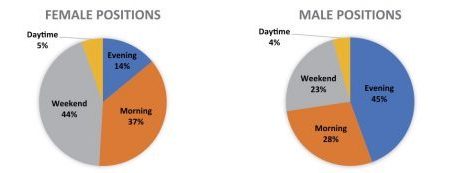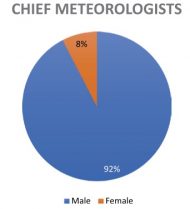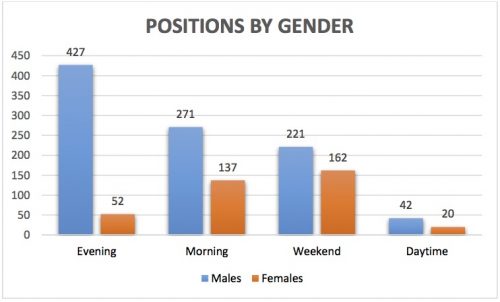The agenda of the 41st AMS Broadcast Meteorology Conference, held today through Friday in Nashville, covers a wide range of weather and meteorology. Not surprisingly, there’s a lot about psychology, too–including one presentation advising on-air meteorologists on “How to Develop Alligator Skin in order to ‘Survive.'”
The following column, by Rob Haswell, a Certified Broadcast Meteorologist in Milwaukee, delves into the ins and outs of that second science all too familiar to weathercasters.
Let me start by saying I love being on TV. I love what I do and everything that comes along with it–even the bad stuff. Sure, I’d like to make more money, I wish I didn’t work at crazy hours, and sometimes I’d like to be able to shop for groceries without dealing with that guy who has to grab my arm and pronounce, “Hey, you’re that guy on TV!”. But otherwise, I love broadcast meteorology.
With that on the record, I have to say there are times when I wish I could just forecast and not worry about how it was heard by the viewing and listening public. How a forecast is received has numerous variables that are outside of the realm of atmospheric science. Viewers have a form of selective listening that causes them to hear what they want–or not hear you at all. They want specifics but demand we generalize everything, and they suffer from severe long-term memory loss that causes them to relate only to what is happening in the present or very near past and future.
Perhaps the biggest challenge to any broadcast meteorologist is that of selective listening on the part of viewers or radio listeners. It’s similar to the selective hearing that children have: they can’t hear their own name shouted from the front porch but can make out the bells of an ice cream truck from miles away. Let’s take, for example, a viewer who has weekend plans to play golf or attend a wedding. When a forecaster says there is a chance of rain on Saturday, a pessimist will hear, “Your golf game will be rained out,” while an optimist (or perhaps someone in denial) will hear, “Your wedding will be beautiful and dry.” None of that changes what the actual chance of rain is for that area.
The human ear is capable of taking in everything we’re saying, but the human brain tends to lean toward the dramatic. So when a forecaster calls for a 7-15 centimeters of snow in an area the viewer will typically only pick up on the higher number and forget the lower number. When the storm passes with an average of 7-9 centimeters the viewer accuses us of exaggerating for ratings. This becomes an even bigger challenge when a broadcaster covers a large area with a variety of microclimates or that is affected by systems and fronts differently. If I feel the storm will leave 10-15 centimeters in our northern coverage area I will inform viewers to expect that snow north of a major east-to-west route just south of the snowfall forecast area. Nonetheless, a viewer well south of that route might just hear 15 centimeters and then cry foul when their area does not get that much snow! Then, when we explain to that viewer that his or her area was not in the forecast to get that much snow, they will might accuse you of “massaging your numbers” or simply deny you ever said such a thing. Are they delusional? No. They heard what they heard and that is their own reality.
Of course we could combat this by providing a more detailed forecast. In some ways the internet enables us to do that. We can put more detailed information online than we can present on the air. However, despite viewers’ demand for accuracy, they also demand brevity and generalities. Yes, a growing group of weather junkies love it when I break out the water vapor imagery or talk about vorticity, but the much larger group simply wants to know if it is going to rain or snow. We have to cater to the crowd that wants to know if it is sweater weather or t-shirt weather. We must remember that we are only part of a program whose main goal is to attract a large audience, not necessarily to teach the viewer about the intricacies of the atmosphere. We can’t expect a television or radio station to devote enough time for a complete, in-depth forecast discussion in each and every quarter hour.
So, viewers demand that I tell them the amount of snow in their driveway to the centimeter or the exact high temperature to within a degree for their backyard, but at the same time they want me to tell them in a brief, generalized manner that doesn’t overly tax their brains. In a sense, they are their own worst enemies if they want a more accurate forecast.
Lastly, the broadcast meteorologist is up against the viewer’s memory. Today’s viewer lives in the now. Our father’s and grandfather’s generations were more connected to the world around them in their daily lives. They seemed to remember what last winter brought and what the average spring is. That was partly because families weren’t as mobile then. Nowadays it’s common to move across the country or across the world, and as a result people don’t know their local climate. However, the average person–in particular from post-GenX generations–have short attention spans, which leads to confusion about climate–and in particular when discussing climate change.
Take for example the colder- and snowier-than-average February and March in much of the Great Lakes. Due to some late-season snowfalls and cold snaps, viewers were convinced that this was the harshest winter on record. They were incapable of remembering the well above-average December or the nearly snowless January. This climate amnesia is a “what have you done for me lately?” mindset.
This memory problem—this “now” focus—hits fever pitch on the issue of global climate change, which, sadly, is so contentious that very few on-air meteorologists will even touch it publicly. If a few days in a row are unseasonably cold it won’t be very long before the broadcast meteorologist has to contend with e-mails or Facebook posts snarking, “Where’s Global Warming now?!” Or if we manage, as we did here in Wisconsin, to have a couple of below-average months back to back, you’ll hear calls of “Global Warming Fraud” because viewers have forgotten the numerous consecutive months of above-average temperatures, not to mention the deadly heat or extensive drought of the previous summer.
There you have it. The broadcast meteorologist is up against not only the scientific challenges of forecasting but also the challenge of psychology. We’re speaking to an audience of selective listeners who hear what they what to hear. A group of folks who want spot-on accuracy delivered in broad strokes and witty banter. And an audience that seems to relate only to what is happening in the world around them at this very moment.
So do we give up and just assume we’ll never get through to them? No. These are just challenges, not insurmountable obstacles. Broadcast meteorologist need to use all the tools at their disposal to provide specifics and focus their audience on what they need to know. Use Twitter and Facebook to engage the viewer and keep the forecast up to the minute. Take advantage of the internet to post more detailed data for those who crave it, and use the on-air portion of our job to create more weather junkies who will consume that data. We need to keep it simple while at the same time not falling for the traps of oversimplification. We need to use climate as a history lesson for the viewer to remind them over and over about what the world outside has been like so as to put today’s weather in context.
Lastly, we need to grow a thick skin. For no matter how much we work at educating, informing, and entertaining, some viewers will always revel in what they see as our shortcomings. Remember the old saying, “Weep for the weather forecaster. When he’s wrong, no one forgets. When he’s right, no one remembers.”


 Listen from the
Listen from the 
